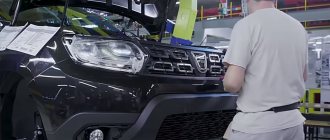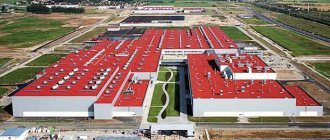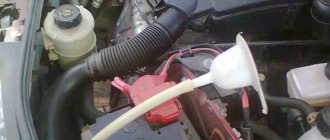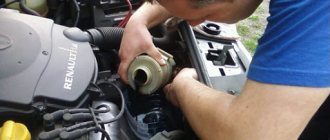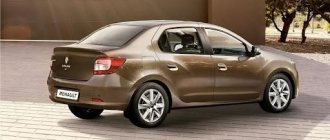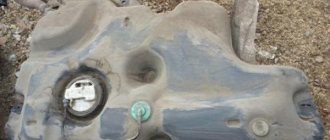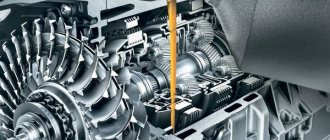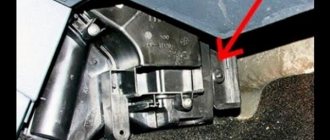The quality of car assembly at different enterprises often varies, and this also applies to Renault products.
Even though the cars are created using the same technologies and under the strict control of the company, the assembly plant is important. Let's talk about where the famous Renault Logan is produced - the symbol of the automaker.
Logan is manufactured all over the world, including in our country. Thus, the production of Renault Logan until 2015 was established at the Avtoframos plant (since 2014 Renault-Russia), after which production was transferred to the facilities of AVTOVAZ, which is part of the Renault-Nissan alliance. More details below...
2nd generation
A little about Renault production
Renault headquarters in France
Renault is more than a hundred years old and is the fourth largest concern in the world in terms of annual sales.
The manufacturer Logan achieved its success primarily through close cooperation with other concerns, in particular, it created a joint holding company with Nissan. Today Renault Logan is produced in Romania, Brazil, India, Iran and Russia.
AVTOVAZ has become a partner of the company in Russia , where they assemble Renault Logan adapted for the Russian market. Until 2015, production was located at its own automobile plant in Moscow, where popular Renault models are assembled, such as the Duster, Captur crossovers, etc. Russian-assembled foreign cars are supplied to some CIS countries.
Review of Renault Logan engines
Main Renault factories and assembly sites in the world
Renault's country of origin is France. But in Europe, labor is very expensive, and the construction of additional factories in little France will usually cost astronomical sums. Therefore, the company is pursuing other opportunities to expand. Either the plant is built in third world countries or bought by other companies in Europe. Thus, the company was able to expand its presence in the world, and most of the cheap cars coming to Russia are not assembled in France. Main factories and assembly sites for Renault vehicles:
- France - not far from Paris is the first and once main plant of the company, which serves for the development and invention of new technologies;
- Romania - the former Dacia corporation is almost entirely owned by Renault; all Romanian Dacia factories produce French cars;
- Korea: The Samsung brand is 80% owned by Renault, with many production facilities used to produce cars;
- Brazil is one of the company's largest assembly plants, supplying cars to all Latin American countries;
- Russia - for starters, Renault owns 50% of AvtoVAZ, and some models are also assembled with updated production lines.
It is worth noting such cooperation as the Renault and Nissan alliance. These are two companies that can boast of fruitful cooperation. In 2014, this alliance became the world's fourth largest automobile manufacturer. Renault owns more than 40% of Nissan shares, so today the French have almost complete control over the work and development of this company. However, the competitive environment between these brands remains, since the companies are located in approximately the same segment, each development is a potential competitor for its brother company. Despite all the difficulties, the Renault-Nissan cooperation brings many positive aspects in the exchange of technologies and the acquisition of new production capacities.
History of Renault
Assembly shop
Renault entered the Russian market at the beginning of the 20th century: cars of this brand were liked by the royal family.
Shortly before the revolution, the French company organized the Russian Renault joint-stock company and even managed to begin construction of an assembly factory in the city of Rybinsk, which was subsequently nationalized by the new government. The policy of the Soviet Union did not provide for the participation of private capital in industry, but in the 60s, Renault managed to establish technological cooperation with the USSR, making a tangible contribution to the development of the Soviet automotive industry.
"Renault Russia"
"AVTOFRAMOS" RENAULT
In 1992, Renault opened a Moscow office, and in 1998 it entered into an agreement with Moscow to organize joint production.
The new company was named “Avtoframos” (a compilation of “Automobile”, “France”, “Moscow”). In 1999, production of Renault passenger cars was opened on the basis of the AZLK plant, which had fallen into disrepair.
In 2005, the international company completed the construction of a plant in the capital, Renault began producing the Logan model. Thanks to its high reliability and affordable price, it will become the best-selling foreign car in Russia. Gradually, the concern's share in the capital of Avtoframos will increase until it reaches 100%. In July 2014, the company changed its name to Renault Russia.
Renault Logan wheels: wheel and tire sizes
Cooperation with AVTOVAZ
Production of Renault Logan at AVTOVAZ
The joint work of the international concern and AVTOVAZ began in 2008, and by 2013 Renault received a controlling stake in the Volzhsky Automobile Plant. Since then, cooperation between the two companies has only been developing. The foreign manufacturer helped AVTOVAZ overcome the crisis and modernize its workshops, at the same time increasing its influence on the Russian passenger car market.
Since 2015, Logan has also been produced at the Volzhsky plant. The new product has been a success among our drivers since the first days of sales.
Renault Logan, adapted for the Russian market, has retained the low price and best features of the previous model, while at the same time becoming even more reliable.
Quality of Russian assembly and comparison with other options
Logan is assembled in seven factories around the world, located in Romania, Morocco, Brazil, India, Iran, Colombia and Russia. This is an inexpensive car, which they decided to leave for developing countries, but the Romanian assembly began to be actively sold in Europe. Against the background of the general financial crisis, the new generation Logan was able to surpass Volkswagen in Germany in sales, which was previously impossible for other cars. The Russian assembly of the second generation Renault Logan is practically no different in quality from the Romanian one, which is considered standard. In Brazil, Colombia and other exotic countries, the company assembles Logans in old factories without much modernization, so their quality leaves much to be desired. The features of the Russian car assembly are as follows:
- Logan in our version is made of the same materials as the European version;
- On the Togliatti assembly line, the French created a complex for automatic car assembly;
- the company provided foreign inspectors and controllers who certify the quality of each stage of work;
- each automobile unit is tested before entering car dealerships;
- the cars have surprisingly high-quality internal assembly, hard plastic does not creak or crumble;
- all parts know their place, the car owner will not have any questions regarding assembly;
- The power unit and gearbox are supplied from Romania, large-scale assembly of the car is carried out at AvtoVAZ.
Despite such similar characteristics of the Russian and Romanian assemblies, different equipment is used in Russia. The engine remains the same as the first generation, but in Europe Logan is sold with 0.9 and 1.2 liter power units. The price of a car in Europe in 2012 started at 6.5 thousand Euros, which is why there are such large-scale sales in the Old World. In Logan, the manufacturer has combined several aspirations of European thinking: the desire for practicality, low price and low fuel consumption. It was these characteristics that influenced car sales in some European countries. By the way, Logan was withdrawn from European sales today.
Some numbers
Renault car plant in Moscow
We will try to present the activities of the largest plant in Russia , where Renault cars are produced today, in the form of numerical data:
- 2007 – 69 thousand cars
- 2008 – 73 thousand cars
- 2012 – 167 thousand cars
- 2015 - the millionth foreign car rolls off the assembly line, in the same year Renault withdraws Logan from production and moves it to Tolyatti
- The car plant's capacity for 2016 is 180 thousand passenger cars per year.
- Number of personnel – 2.3 thousand people
- Localization level for 2007 – 50%
- Localization level for 2022 – 70%
Renault Logan clutch replacement
Wide range of models. One homeland - many “addresses”!
Are we still talking about Renault? What models is this company ready to offer on the world market? We see that a successful project, opened in 1899 in France, gradually turned into a luxurious business that glorified the founding brothers around the world. At the moment, the popularity and level of profitability of the company is constantly increasing. Renault merged with Nissan. The two companies are merging into the largest holding. Now it is difficult to immediately answer in which country Renault produces, because cars of this brand are successfully and en masse assembled on different continents, in different countries. To find out where a car came from, you need to know the specific model.
Now Renault has also become AvtoVAZ's most influential partner. After all, Renault now owns a quarter of the shares of the largest domestic automaker.
Experts have identified several factories that produce Renault in different parts of the world.
- AvtoVAZ produces cars for Russian consumers.
- Cars from the Romanian plant are mainly supplied to the European market. There are also Romanian-assembled cars in Russia.
- Cars from the Brazilian plant no longer reach Russian motorists.
- There is another domestic plant near Moscow. A huge number of Renaults for Russia are produced here.
- Renault cars arrive in Africa, Asia, and India from a large Indian automobile plant.
Obviously, Renault is already so widespread in the world that cars are produced in different countries. The assembly location of a particular brand depends on the roads on which it is currently moving.
Where is Renault (not Logan) assembled in Russia
The Moscow Renault plant amazes with both the scale of investment in the Russian auto industry ($1.5 billion) and the degree of automation of its production.
analogues to the enterprise where passenger cars are assembled in the same quantity in our country . And today you have the opportunity to take a virtual tour of the super plant with us.
Director of the Renault plant in Moscow Jean-Louis Theron
Note! Popular Renault models are produced here, but not Logan. Its assembly was transferred to AVTOVAZ.
The car plant, where tens of thousands of cars are assembled a year, is amazing in scale. Logistics here is carried out by robotic carts that tirelessly transport goods along special magnetic tracks. There are a total of 110 such carts at the enterprise, all of them controlled from one server.
Welding of body panels is carried out by special robotic arms.
Manipulators install the panels on the stocks and then begin work. You can watch this fascinating process endlessly.
The body undergoes geometry control - at 16 thousand control points!
Not all work can yet be done by machines; there is also a place for manual labor.
The body is then sent to the paint booth.
The quality of the paintwork is checked several times.
Sometimes defects are found.
An experienced employee is responsible for finding and eliminating painting defects.
The painted bodies move further along the conveyor, where they are assembled into a car.
The speed of the line where the cars are assembled is 33.5 pcs. at one o'clock.
The company has a 5S system - sort, standardize, keep order, keep clean, make it all a habit.
There are posters everywhere reminding you of the importance of quality. The USSR immediately comes to mind.
It takes just over a day to completely assemble one car. At the end, the transport is filled with technical fluids.
Engine number, paint code and VIN Renault Logan
Brazil
The history of work in Brazil is very interesting. In fact, he has worked in this country along with the American one since 1960. But since 1970, the company left the Brazilian market. He managed to return to this country again and start producing his own cars only in 1997. Interestingly, it was in Brazil that the first Renault-Meganes were produced, which were successfully produced until 2012. Subsequently, the plant switched to production of more recent models: Sandero, Master, Logan, Duster, Capture. In 2015, the first pickup truck based on the Duster car was released. The Logan is still produced in Brazil.
First restyling of Renault Logan 1
The restyling of the 1st generation Logan was carried out in 2009, and the second generation debuted on the automobile market in 2012.
Logan-2 has been sold in the Russian Federation since March 2014, and although many years have passed since the start of production, the brand has not lost its relevance.
The restyled version of the first model from the French company Renault was produced in sedan, station wagon, pickup and van bodies; only sedans were and are offered to domestic consumers.
Although the car has gained great trust among motorists and is considered “indestructible”, some shortcomings and disadvantages should be noted along with the advantages.
Popular model options
Where are BMWs assembled in Russia?
Renault Logan 2009 offers its buyer several equipment options.
The simplest version is called “Authentique” and cannot boast of a wide range of options. The minimum of ordinary functions includes a single airbag, a hydraulic power steering unit, a “native” anti-theft system and the ability to heat the stern glass.
The “Expression” version has a 1.6-liter engine, the output of which, depending on the version of the head, can be 82 or 102 “power”. The manufacturer did not skimp on the quality of the transmission and, along with the “mechanics”, “happy” this modification with a classic “automatic”. Additional options include electric windows and central locking.
The “Privilege” variation will allow its owner to experience the beauty of a more complete list of options. To the above features, the manufacturer added an audio system, air conditioning and an airbag designed for the safety of the front passenger.
The most “sophisticated” version of “Prestige” is sold in a custom mode and will delight you with a truly impressive list of equipment.
Which cars have a galvanized body?
The galvanized body does not corrode and lasts longer thanks to a special coating – zinc. Not all cars are galvanized; this is an expensive proposition. Let's look at which cars have a galvanized body. Manufacturers, especially on older cars, use zinc-containing primer.
It's cheaper and easier. It is also reliable, but it will not replace full galvanization. The maximum warranty period for galvanizing is 15 years.
But there are galvanized cars that are 30 years old and have not a hint of rust on them. It is advisable to carry out anti-corrosion treatment of the body once every 3 years, especially if you earn money from a car. This way you will extend the life of the “iron horse”.
If you treat your car with care, look after it, and drive carefully, it will repay you with a long and impeccable service, regardless of the manufacturer.
Audi (almost all models), Ford (most models), new Chevrolet, Logan, Citroen, Volkswagen, all Opel Astra, Insignia and some Opel Vectra. Skoda Octavia, Peugeot (all models), Fiat Marea (models from 2022), all Hyundai have a galvanized body, but after damage to the paintwork, rust quickly appears.
All Reno Megan and Volvo models from 2005. Modern Ladas come with a partially galvanized body, while the Lada Granta has the entire body. The list could take a long time; it’s easier to look at the website of a specific manufacturer and see what it offers.
Snow containing salt damages the anti-corrosion layer.
Try to drive carefully on dirt roads.
Accidentally flying stones from tires can damage galvanizing
In conclusion, I’ll add: it doesn’t matter what brand of car you have, the price, the manufacturer, the main thing is your attitude towards it
With careful operation and timely maintenance, even a “decrepit old lady” will last a very long time.
What comes from where and how is it produced?
Sometimes our brother, the automotive man in the street, engages in banter, claiming that what our domestic auto industry can do besides welding tank hulls and armored personnel carriers?
Well, let’s say, they say, the French will teach our “specialists” to weld the bodies of Renault cars, but everything else, right down to the screws, as well as paint and primer, are supplied exclusively from Champagne, or from some other French province . Ours are not even able to paint the body!
Consider the rigmarole with Logan (assembled at that time by Avtoframos), when in 2005 the first hundred of these cars were rejected even by our car enthusiasts, accustomed to all surprises and shortcomings, because of rust that appeared almost from the first trip. Well, here we go, they say, Logan is rotten through and through!
The bourgeoisie came in large numbers and began to sort it out. It turns out that the bourgeois paint did not adhere to our domestic primer.
And engines of Spanish origin, by the way, also had problems.
But it’s okay, our national peculiarity lies in the fact that at least at a trough, but at least this trough leaves the gate, and then everything, down to the bolt, will be twisted, remade and completely forgotten.
On one assembly line, three models are currently being assembled simultaneously - these are Kaptur, Duster and Arcana. The French have perfected the technology for changing equipment, as they say “on the fly”, without stopping the conveyor. And for this we had to:
- – change a third of the welding equipment;
- – install robots for welding both floors and side members;
- – modernize the painting complex to work with two colors of paint at once;
- – additionally set up control posts.
As for control, this is, first of all, checking the body geometry, welds and paint quality.
The localization percentage of Renault Arcana, or the indicator of assembly parts and assemblies manufactured at Russian facilities, is about 70 percent, as reported by one of the managers, namely Jerome Pano.
Romania
The small town of Pitesti in Romania would have remained insignificant, but in 1968 Renault burst into its life. Everything has changed since then. The company bought a controlling stake in the existing Dacia production and began producing its own cars. Now the Romanian Renault car is sold in the markets of Ukraine, Moldova and other EU countries.
The main achievement of the plant was its participation in the development of the legendary Renault-Logan car, which was very much loved by the people of Russia. Another milestone is the construction of a plant for the production of components for the subsequent assembly of cars. The plant is so large that the parts produced are shipped all over the world. In 2022, the plant where Renault Logan is assembled increased production. By the end of this year, production of 235 thousand cars is expected.
Sources
- https://NpfGeoProm.ru/ino-brendy/gde-vypuskayut-reno-logan.html
- https://gdesobiraut.com/strana-proizvoditel/renault/
- https://strelka-detector.ru/ino-brendy/gde-sobirayut-reno-logan-v-rossii.html
- https://PromkomRostov.ru/brendy/gde-sobirayut-reno-v-rossii.html
- https://VmyatynNet.ru/inomarka/reno-proizvoditel.html
- https://kvadrocikly-stels.ru/inostrannye-avto/reno-vikipediya.html
- https://moylogan.ru/reno-logan-chya-mashina-strana-proizvoditel/
- https://art4online.ru/sovety/gde-sobirayut-reno-logan.html
- https://mobile-dvr.ru/ekspluatatsiya/gde-sobirayut-reno-logan.html
- https://AutoTopik.ru/renault/1308-strana-proizvoditel.html
- https://avto-layn.ru/inomarka/gde-vypuskayut-reno-logan.html
- https://forte-drilling.ru/ino-brendy/proizvoditel-reno-logan.html
Iran
The first cars of the Renault family were produced in Iran in 1976. At that time it was a popular Renault-5 model. Already in 2004, an agreement was signed between the presidents of Iran and Renault on the creation of joint automobile production in the country. Thus was born the Renault Pars company, specializing mainly in the production of Renault-Sandero. There are no plans to assemble Renault-Logan at Iranian factories yet.
In 2022, Renault announced the construction of a new automobile plant near Tehran. Once fully operational, the plant will be able to produce up to 15,000 vehicles per year, almost doubling production. This progress was facilitated by the lifting of sanctions against Iran by the European Union.
Which cars have a galvanized body?
The car body can be completely galvanized or only partially galvanized. Cars with predominantly galvanized bodies are produced by automakers such as Audi, BMW, Volkswagen, and Porsche.
If we consider specific models of cars with a galvanized body, we can name the following: So you need to be more careful when purchasing a galvanized car. Now many German, American, French, and Japanese cars have galvanized bodies. Although skeptics believe that a galvanized body is more difficult to paint.
Currently reading: Exhaust pipe seal (metal ring) RENAULT 6001547473 Renault. Wholesale and retail.
Sometimes only the thresholds, bottoms, and bottoms of doors are galvanized.
The list of such cars is large, we can mention the Chevrolet Lacetti, many Skoda, Volkswagen models. Of course, Audi has the best galvanized bodies - double-sided galvanic zinc coating of the entire body.
The technology is quite complex; not all manufacturers can reproduce this technology correctly.
There are quite a lot of cars with galvanized bodies! There are still cars among expensive foreign cars: Audi A 6 (1994 - 1997), BMW, Porsche, Volkswagen Gol3, for example. There are, of course, more budget car options.
For example, Renault Logan (very popular), Chevrolet, Peugeot (best of all 307). And you can also buy the same car, only used, but in excellent condition.
If the price doesn’t stop you, take the cars listed above. I heard that the old golfs are galvanized, and Izha Oda seems to be the same, they say that Toyota is also galvanized. During the USSR, the legendary Volga GAZ 21 had a galvanized body!
Since 1998, almost all European manufacturers have switched to producing cars with galvanized bodies or at least the most vulnerable parts.
As far as I know, the manufacturers quot;Audiquot; became pioneers in this matter.
Today you can often find the characteristic of a galvanized body in the description of a car. But in reality it turns out that not every body is actually treated with zinc. Usually some part is galvanized.
But only some models are completely treated with zinc; they can last quite a long time. This list is divided into cars that were galvanized: Volvo, all cars starting from model 240, Chevrolet Lacetti, Fiat Albea, Opel Vectra, Opel Astra.
So just don't buy old cars or cheap Russian and Chinese ones.
Then there will definitely be no problems with the body.
Let's go! —
heard one of the authors in response to the thoughtful reasoning outlined above. - All this is correct, but now take this trunk and take it to that Duster over there! When, instead of the usual foreign test drive, Za Rulem offered to take part in driving the car to Moscow, doubts arose only about the choice of route.
In order to be on time with the material for this issue, I had to abandon the idea of coming to Russia in a Duster. We preferred one and a half thousand kilometers of Spanish-French highways and a small but indicative part of the prairies... or whatever they call it, where you drive off the asphalt.
Another sign is on the parting panel: the symbols D and 4WD LOCK.
Another sign is on the parting panel: the symbols D and 4WD LOCK.
Another sign is on the instrument panel: symbols D and 4WD LOCK
To say that the all-wheel drive Duster with an automatic transmission immediately stands out against the background of its front-wheel drive older brother is to sin against the truth. Set the mode to 2WD - and here you have the same car. Go and feel how much the gear ratios in the transmission have been changed (answer: increased by about 5%).
By the end of the second day, consumption measured at 10.2 l/100 km at an average speed of 72.9 km/h. It could have been smaller, but for this the “automatic” lacks a couple of steps. “Duster” is by no means a testing ground for new technical solutions; it tries on time-tested (read: inexpensive) units.
The trunk of the 4x4 version is 67 liters smaller because it has a higher raised floor. But the spare tire is placed directly under it, and not fastened outside in the rear overhang. Getting it out of there, much less putting it away, is a dubious pleasure.
The trunk of the 4x4 version is 67 liters smaller because it has a higher raised floor. But the spare tire is placed directly under it, and not fastened outside in the rear overhang. Getting it out of there, much less putting it away, is a dubious pleasure.
The trunk of the 4x4 version is 67 liters smaller because it has a higher raised floor. But the spare tire is placed directly under it, and not fastened outside in the rear overhang. Getting it out of there, much less putting it away, is a dubious pleasure.
When overtaking, the automatic transmission decisively shifts to a downshift, forcing the engine to howl in an attempt to accelerate the car. Alas, its efforts are lost somewhere between third and fourth gears, so the sluggish advance doesn't match the noise effects at all.
What is it for?
Today, automakers have a whole range of measures in their arsenal to ensure the safety of the body panels of their creations from the effects of corrosion, but many people are interested in whether the body is galvanized before purchasing a car, because this is excellent protection for the car.
The first option is to place as many moldings and other protective polymer panels on the body elements as possible. This allows you to secure multiple “problem areas”.
The second method is to use a special coating of the body with certain compounds. Due to this kind of preservation, the metal of the body can “live” for quite a long time.
If the future owner plans to purchase a Renault Logan, then he should not have any concerns about the durability of the bottom. At the factory, this car receives a reliable anti-corrosion coating, which allows it to withstand with enviable dignity the entire galaxy of hardships that plague Russian climatic conditions. The guaranteed period for maintaining protective properties is close to five years. Next, you will need to update the coverage.
Currently reading: Comparison of Lada Kalina 2 with Renault Logan
We've sorted out the bottom, but what can we tell you about the Renault Logan body panels? The owners have already noticed that during 5-7 years of intensive use, the wings, lower door edges, hood and trunk lid are subject to a fierce attack of the “red disease”.
The zinc protective layer, which most budget employees cannot boast of, requires its application before direct factory painting. This coating can prevent the metal surface from reacting with salt impurities and moisture. Manufacturers of such cars provide guarantees for the safety of the body against through holes for up to 10 years.
Galvanizing technology is very common among European and Japanese manufacturers, among even middle-class cars; no one cares whether the body is galvanized or not, of course, yes. Not only passenger cars, but also commercial trucks are treated with this coating.
